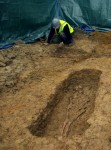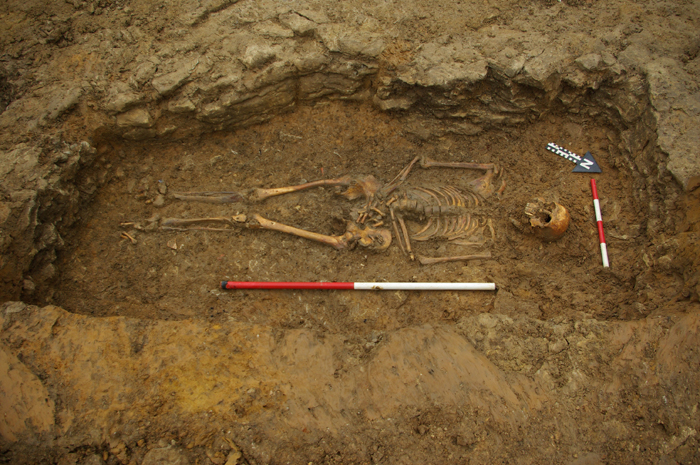Archaeologists excavating the site of former automotive shop in Cirencester, in the Cotswolds, have discovered an extensive Roman burial ground with over 40 inhumations and four cremations.
Preliminary dating based on a pottery flagon found in a child’s grave suggests that the cemetery is from the early Roman period, between 70 A.D. and 120 A.D. If that date is confirmed by radiocarbon dating of the human remains themselves, that would make this one of the earliest burial grounds in Roman Britain and it would upend current historical thought about the overwhelming prevalence of cremation during this period.
Cotswold Archaeology project manager [Cliff] Bateman said the near perfect flagon was a significant find because it indicated the child could also have been buried in the early Roman period. It is thought inhumations were not common practice until after 200AD, so the team believe the find could re-write historians’ understanding of Roman Britain.
A large number of the inhumations were in shallow graves within a marked enclosure, which could have belonged to a family. And the flagon, which was likely to have been made in nearby Purton, was found in a young child’s grave within this enclosure.
Two bracelets made of green glass beads, jet beads, shale and copper alloy and a number of hobnails have also been found in the graves. One of the bracelets was discovered still encircling the skeletonized wrist of its owner.
 This isn’t the first time burials have been found on this very location. When the Bridges Garage was built in the 1960s, archaeologist Richard Reece found 46 cremations, six inhumations and an engraved headstone dating between the first and third centuries A.D. Notice the opposite proportion of inhumations to cremations, which is what historians would have expected.
This isn’t the first time burials have been found on this very location. When the Bridges Garage was built in the 1960s, archaeologist Richard Reece found 46 cremations, six inhumations and an engraved headstone dating between the first and third centuries A.D. Notice the opposite proportion of inhumations to cremations, which is what historians would have expected.
It’s remarkable that after the excavation and construction in the 60s that there was still a burial ground to be found today. The auto shop had two huge underground fuel tanks installed, so archaeologists really didn’t expect to find any material remains undamaged underneath the property. It took them three days of digging before they found the cremations. Then they found three inhumations and every day after that they found more.
The archaeological survey was done at the behest of St James’s Place Wealth Management who intended to build a parking deck on the spot. All construction has been put on hold and additional security hired to police the excavation site.
The artifacts discovered will be conserved and the human remains will be examined in detail at Cotswold Archaeology’s head office. They will be radiocarbon dated and osteological analysis will determine their age, sex, any injuries they might have incurred and whether they were fatal. After the research and conservation are done, the artifacts may go on display at Cirencester’s Corinium Museum.

It still interests me how differently human remains are treated based on how old they are.
very very interesting :yes: